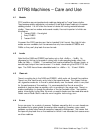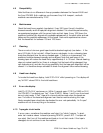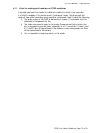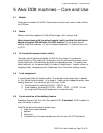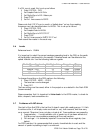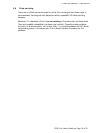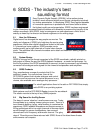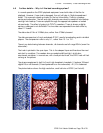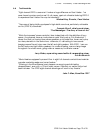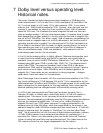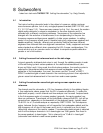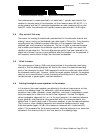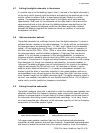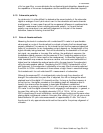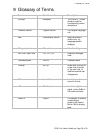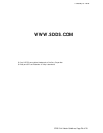7 Dolby level versus operating level . Historical notes.
SDDS Print Master Guidelines, Page 20 of 26
7 Dolby level versus operating level.
Historical notes.
T he current standard for digital cinema s ound has a headr oom of 20dB above the
studio r efer ence l evel. This is usually 0VU in USA/France/Spain/I taly and 0dBu in the
UK. If you look closely at a VU meter, 0VU is also mar ked as 100% . It now s eems
ludicrous that –20dB should be mar ked as 100% . However, when the meter was first
invented, it was decided, for safety that there woul d be at least 10dB of headroom
above thi s 0VU mark. This is because the meter integrates the l evel over time and
gives an average r eading. It will miss instantaneous peaks. It therefore tends to under
read, depending on program mater ial. In the film wor ld the flux level of magnetic f ilm
was set at 0VU=185nWb/m. This allows roughly 10dB of headroom, remembering that
maximum level on magnetic t ape is not a s t r i ctl y defined poi nt, but that the ons et of
saturation and di s tor ti on is gradual. T his reference l evel of 0VU then translated to an
SPL of 85dBc i n the cinema. With the advent of digital recording ther e is no “ons et of
tape s atur ati on grey area” so it is even more i mpor tant to have lots of headroom to
allow for instantaneous peaks. 20dBs was decided on, which seemed to s uit the
instantaneous peaks found i n film sound tr acks .
In the UK the film metering his tor y is slightly different. Reference l evel practises tend
to come fr om the br oadcas t sector and the BBC i n particular was a gr eat setter of
standards. Here you are to fi nd BBC PPM meter s . Marked fr om 1 to 7, with the hi gher
numbers being 4dBs apart. PPM4 is usually 0dBu, PPM5, 0VU. The r efer ence l evel is
usually 0dBu, PPM4. The max i mum (br oadcas t) level is then PPM6, 8 dBs above
reference l evel . PPMs catch all the peaks so give a t r uer picture of the l evel . Tape flux
levels can be s et much higher. 0dBu=200nWb/m was the s tandar d agr eed on for
magnetic f ilm. These meter s are ver y convenient for mixing engi neer s – dialogue
peaks about 4 and mus i c about 5 is a s i mpl e maxim.
When Dolby began their involvement with film sound and noi s e r educti on in the 1970s,
they found a di fference of 0.75dB between USA and UK. This is acco u n t e d for by the
difference between 185nWb/m and 200nWb/m. The s impl e r emedy for this would have
been to change the fl ux level alignment of the mag machines , but in some cas es the
electrical operating level was changed i ns tead, with potentially confusing r es ul ts .
In a U S A s tudi o, operating l evel and “Dol by level” are always the s ame. But in
Germany still today, a s i t uat i on exists where Dol by level is -4.75dB with respect to
operating l evel. The r eas ons for this are pur el y historical and caus e enor mous
confusion. German broadcasting tr aditi onally used the DI N system where the r efer ence
level was the maximum broadcast level. This was set for +6dBu=320nWb/m on
magnetic f ilm and T ype 1 PPM meter s were us ed. To make a wor l dwi de film, the
reference tone has to be 185nWb/m, which then equals 85dBc i n the ci nema. It was
decided to keep the + 6dB= 320nWb/m s tandard and then record tone at –4.75dB with
respect to r efer ence l evel , this equates to 185nWb/m. This was then called “Dol by
Level”. This all worked fi ne, but with the ons et of digital cinema s oundt r ack s , a bi z arre
-4.75dB=-20dBfs scenario was produced and the r eas ons why are bei ng los t. To
counteract this, Dolby is now recommending that new studios follow the “Amer i can”
system of having the s ame Dol by level and r efer ence l evel . This makes sense as the
DIN maximum s ys tem has now largely disappear ed i n the film industr y.



